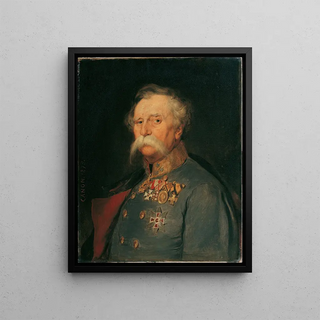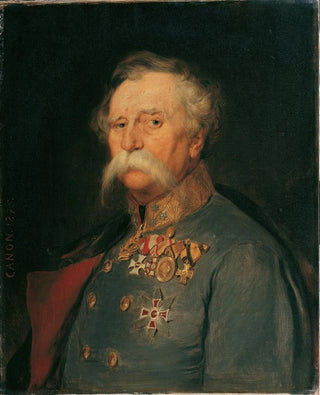Art print | Marshal Franz von Hauslab - Hans Canon


View from behind

Frame (optional)
In the vast panorama of art history, some works stand out for their ability to capture not only the essence of a character but also the atmosphere of an era. The art print of Marshal Franz von Hauslab by Hans Canon is a compelling example. This piece, imbued with dignity and grandeur, immerses us in the military world of the 19th century, where heroism and duty intertwine with the rigor of academic portraiture. The Austrian painter, by choosing to depict this marshal, does not merely pay tribute to a man but also evokes the values and ideals of a society in full transformation.
Style and uniqueness of the piece
Hans Canon's style is characterized by technical precision and meticulous attention to detail. In this work, every brushstroke appears to have been carefully weighed, every color selected to evoke both strength and vulnerability of the subject. The Marshal Franz von Hauslab is portrayed in a richly decorated military uniform, symbolizing his status and power. The background, simple and nuanced, highlights the central figure, creating a contrast that emphasizes the majesty of the character. The light, skillfully manipulated, plays a crucial role in the composition, accentuating facial features and fabric textures. This art print transcends the simple portrait to become a true testament to the art of its time, where realism is combined with a certain idealization of the human figure.
The artist and his influence
Hans Canon, an emblematic figure of 19th-century Austrian art, established himself through his talent and vision. A student of the Vienna Academy of Fine Arts, he developed a style that blends academic tradition with innovation. His approach to portraiture, in particular, was influenced by masters of the past while incorporating contemporary elements. Canon was able to capture the spirit of his era, marked by political and social upheavals, and his works reflect a keen sensitivity to the issues of his time. By depicting military and political figures, he not only documented history but also contributed to shaping the image of these characters in the

Matte finish

View from behind

Frame (optional)
In the vast panorama of art history, some works stand out for their ability to capture not only the essence of a character but also the atmosphere of an era. The art print of Marshal Franz von Hauslab by Hans Canon is a compelling example. This piece, imbued with dignity and grandeur, immerses us in the military world of the 19th century, where heroism and duty intertwine with the rigor of academic portraiture. The Austrian painter, by choosing to depict this marshal, does not merely pay tribute to a man but also evokes the values and ideals of a society in full transformation.
Style and uniqueness of the piece
Hans Canon's style is characterized by technical precision and meticulous attention to detail. In this work, every brushstroke appears to have been carefully weighed, every color selected to evoke both strength and vulnerability of the subject. The Marshal Franz von Hauslab is portrayed in a richly decorated military uniform, symbolizing his status and power. The background, simple and nuanced, highlights the central figure, creating a contrast that emphasizes the majesty of the character. The light, skillfully manipulated, plays a crucial role in the composition, accentuating facial features and fabric textures. This art print transcends the simple portrait to become a true testament to the art of its time, where realism is combined with a certain idealization of the human figure.
The artist and his influence
Hans Canon, an emblematic figure of 19th-century Austrian art, established himself through his talent and vision. A student of the Vienna Academy of Fine Arts, he developed a style that blends academic tradition with innovation. His approach to portraiture, in particular, was influenced by masters of the past while incorporating contemporary elements. Canon was able to capture the spirit of his era, marked by political and social upheavals, and his works reflect a keen sensitivity to the issues of his time. By depicting military and political figures, he not only documented history but also contributed to shaping the image of these characters in the






